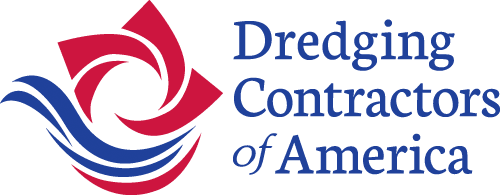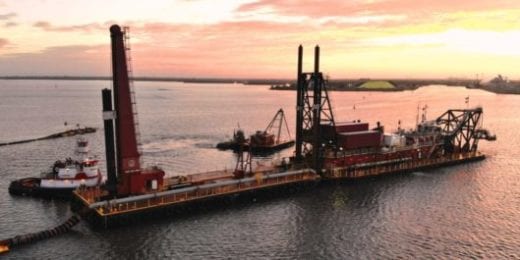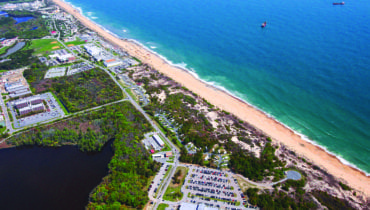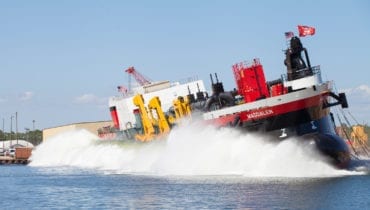Anchored by an expert team of professionals, Great Lakes Dredge and Dock Company (GLDD) completed the Big Bend dredging project in Tampa, Florida twelve months ahead of schedule. GLDD team leaders Russ Zimmerman, South Atlantic Area Manager, Lynn Nietfeld, Corporate Project Sponsor, and Project Manager Tim Kremer kept the project on track and ahead of schedule. GLDD, a U.S-Flag Jones Act dredging company, was able to get a quick jump on the project utilizing two of their large class cutter suction dredges, the CSD CAROLINA and CSD ALASKA .
Commenting on the project, William P. Doyle, CEO and Executive Director of the Dredging Contractors of America, said: “This is excellent. Tampa has been waiting a long time to get this dredging project started, and Great Lakes Dredge and Dock goes in there and tackles Big Bend in six month’s time. Great work!”
The U.S. Army Corps of Engineers (USACE) awarded the competitively bid contract to GLDD in October of 2018. The Port of Tampa Bay is Florida’s largest and most diverse seaport, supporting liquid and dry bulk raw materials, container cargo and one million plus cruise passengers each year. Expanding the Big Bend Channel, which connects to the main channel in Tampa’s harbor, allows for larger vessels to dock along the channel and ease the movement of goods through the port to the Interstate 4 corridor. This project is sponsored by the USACE Jacksonville District, the Tampa Bay Port Authority, the Florida Department of Transportation and two of the port’s largest tenants. The unique public/private partnership has allowed this significant expansion of the port and is expected to have major economic benefits and employment opportunities for both Tampa Bay and the State of Florida.
“This is one of the largest projects we have worked on at Port Tampa Bay,” said Port Tampa Bay President/CEO Paul Anderson. “This is a legacy that truly reshapes our economic landscape and will impact generations to come.”
Lasse Petterson, Chief Executive Officer of Great Lakes Dredge & Dock Company, commented, “We are proud to partner with the USACE Jacksonville District and local officials in executing this important infrastructure project. This complex deepening work was well suited to our proven special experience and expertise in sand, clays, and hard rock and solidifies our position as the leading contractor for difficult port deepening projects. We thank the USACE for their confidence in our ability to execute on this important project, and we are pleased with the successful outcome, ahead of time and on budget.”
The wider, deeper channel will allow for post and neo-Panamax ships to call at the port’s 270-acre Port Redwing terminals. The Big Bend Channel connects to the main channel in Tampa’s harbor, creating a link for the movement of goods between the Interstate 4 corridor and import/export markets in Asia, Europe and Latin America.
David Simonelli, President GLDD Dredging, commented, “Great Lakes is pleased to have competed the Big Bend Terminal well ahead of schedule. We utilized the powerful cutter suction dredges Alaska and Carolina on this project, and they proved to be essential. These vessels along with support equipment excavated over 4.1 million cubic yards of material to deepen and widen the entrance channel, turning basin, and berthing areas of Big Bend. Material was pumped to an in-bay disposal island.”

The Tampa Harbor – Big Bend Channel Federal Study received a USACE Chief’s Report on October 13, 1998, and Congress authorized the project in the Water Resources Development Act (WRDA) of 1999. Congress first designated it as a “new start” in the 2003 Consolidated Appropriations Resolution. The project has been tied up in regulatory wrangling and other environmental reviews for the past two decades.
The local ship pilots had indicated for years that wind forces acting on light loaded or empty barges, when passing through the project channel, resulted in several groundings and collisions with channel markers. Deepening and widening of the channel will help alleviate these navigational hazards. In addition, the accumulation of sediment, commonly referred to as shoaling, had restricted the width of the project channels and reduced its depth.
The scope of the Big Bend dredging project included the following:
• Deepening various parts of the channel and turning basin from 34 to 43 feet;
• Widening the entrance channel from 200 to 250 feet for a length of 1.9 miles;
• Expansion of the existing turning basin to 1,200 feet; and
• Beneficial use of dredged material created 100 acres of new environmental bird habitat for nesting and roosting areas.
Featured image at top – GLDD cutter suction dredge Alaska
See original article by Heiko Osterchrist, Associate Publisher at DredgeWire – View Here







